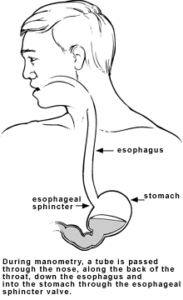
A long tube is inserted into the nose and down the esophagus during an esophageal manometry. The goal of this procedure is to identify whether or not the lower esophagus sphincter and the esophagus muscles are working hard enough to get food to pass through.
What is it?
An esophageal manometry is used to find out if the patient’s lower esophageal sphincter is working to keep reflux from happening and lower esophageal muscles are able to move food along normally. If a patient is having unexplained difficulty swallowing or heartburn/chest pain, doctors might try this procedure if they think something could be wrong with the esophagus.
What should I do to prepare?
It is important for individuals to communicate any heart and lung conditions or any other diseases they have had in the past. Individuals should not consume food within four to six hours prior to the procedure and may need to avoid certain dietary supplements and medications. It is important for individuals to remember to have a long talk with their doctors about the medications they are taking and whether or not they should be continued or put on hold for the procedure.
What happens during the process?
During an esophageal manometry, doctors will begin by applying an anesthetic cream to the nose to allow the tube to pass without causing discomfort. The patient may feel some discomfort as the tube is being placed and it is rare, but possible, that gagging or vomiting can occur. Once the test starts the patient will lie on their left side. The tube has sensors along it and measures the strength of the esophageal muscles. The doctor will ask patients to drink some water during the test. As they drink the water the tube picks up information about the working esophagus. The test should last around 10 to 15 minutes. Once complete, the tube will be removed and the results will be examined.
What are the risks and potential complications?
- Nosebleed
- Sore throat
- Puncture in the esophagus
Disclaimer:
All GlobeHealer Site content, including graphics, images, logos, and text, among other materials on the site are for educational purposes only. This content is not intended to be a substitute for professional medical advice, and you should always contact your physician or qualified health provider for information regarding your health. Information on this site regarding the overview, diagnosis, and treatment of any kind should be looked at, in addition to the advice and information of your health care professional. Do not disregard medical advice or delay seeking treatment or medical advice due to information found on the GlobeHealer site. If there is even the possibility that you may have a medical emergency, seek treatment, call your doctor, or call your local emergency telephone number immediately. GlobeHealer does not endorse being the first line of communication in case of emergency and does not endorse any specific test, physician, facility, product, procedure, opinion, or other information that is or may be mentioned on this site or affiliated entities. Reliance of any and all information provided by GlobeHealer, its employees, affiliations, others appearing on the Site under the invitation of GlobeHealer, or visitors of the site is solely at your own risk and is not the responsibility of GlobeHealer.
Image Source: http://my.clevelandclinic.org/health/diagnostics/hic_Esophageal_Manometry_Test
